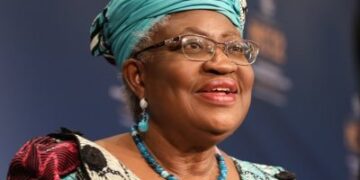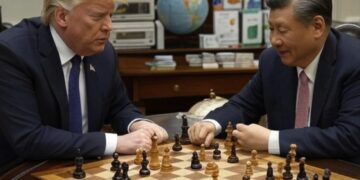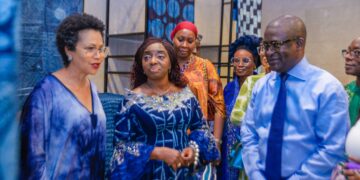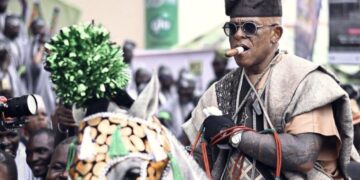Messi not only inherited Maradona’s mantle but elevated it, culminating in a triumphant 2022 World Cup victory that cemented his legacy as one of the greatest players of all time. This succession stands in stark contrast to Nigeria’s ongoing struggle to find a worthy replacement for Augustine “Jay-Jay” Okocha, the mesmerizing number 10 whose flair, creativity, and audacity once lit up pitches across the world. More than 15 years after Okocha retired from international football in 2006, Nigeria’s Super Eagles remain without a prolific playmaker to fill his void. For a nation of over 200 million people with a rich footballing heritage, this persistent gap raises a pressing question: What is hindering Nigeria from producing another world-class number 10?
The Okocha Legacy: A Benchmark of Brilliance
Jay-Jay Okocha was more than just a footballer; he was a phenomenon. With 73 caps and 14 goals for Nigeria, Okocha’s contributions transcended statistics. His dazzling dribbles, signature stepovers, and ability to unlock defenses with a single moment of genius made him a talisman for the Super Eagles. He played a pivotal role in Nigeria’s 1994 Africa Cup of Nations triumph and the 1996 Olympic gold medal win, showcasing a blend of technical mastery and fearless creativity that earned him recognition as one of Africa’s greatest-ever players. His stints at clubs like Eintracht Frankfurt, Fenerbahçe, Paris Saint-Germain, and Bolton Wanderers further solidified his reputation as a global icon.
Okocha’s brilliance lay in his ability to embody the number 10 role: a playmaker who could dictate the tempo, create chances, and inspire teammates. His retirement left a vacuum that Nigeria has struggled to fill, despite the nation’s abundance of footballing talent. While Argentina found in Messi a successor who matched and surpassed Maradona, Nigeria’s search for Okocha’s heir has been marked by false dawns and unfulfilled potential.
The Talent Pipeline: Where Are the Playmakers?
Nigeria has never lacked raw footballing talent. From Nwankwo Kanu to Victor Osimhen, the country has produced world-class forwards, tenacious midfielders like Sunday Oliseh, and robust defenders such as Taribo West. Yet, the specific profile of a prolific number 10—an attacking midfielder with vision, flair, and technical ingenuity—remains elusive. Several factors contribute to this drought.
First, the domestic football system in Nigeria struggles with structural deficiencies. Unlike Argentina, where a well-organized youth development framework nurtured Messi through La Masia via his move to Barcelona, Nigeria’s grassroots football often lacks the facilities, coaching, and consistency needed to refine creative talents. Okocha himself has spoken about this disparity, noting in a 2023 interview with Arise News that Europe provided him with the environment to thrive—something he believes Nigeria still cannot offer its young players. Street football, where Okocha honed his skills, remains a breeding ground for talent, but without structured academies to polish these rough diamonds, many potential playmakers fall through the cracks.
Second, the tactical evolution of modern football may be stifling the emergence of traditional number 10s. Globally, the game has shifted toward high-pressing, physically demanding systems that prioritize versatility over individual flair. In Nigeria, this trend is evident in the national team’s reliance on industrious midfielders like Wilfred Ndidi and Joe Aribo, who excel in box-to-box roles but lack the creative spark of an Okocha. John Obi-Mikel, once tipped as a potential successor, transitioned into a deeper, more defensive role at Chelsea, highlighting how club demands can reshape a player’s instincts.
Missed Opportunities and Missteps
Over the years, Nigeria has seen glimmers of hope in players who promised to revive the number 10 role. Mikel’s early career suggested he could be the heir apparent, with his vision and technique drawing comparisons to Okocha. However, his repositioning as a holding midfielder at club level curtailed his attacking output for the Super Eagles. Similarly, Alex Iwobi, Okocha’s nephew, possesses flair and creativity, but his role at Arsenal and later Fulham has leaned more toward wide playmaking than central orchestration.
Joe Aribo, currently with Southampton, has also been hailed as a potential solution. His performances in the 2019 friendly against Ukraine showcased his ability to drive forward and create, prompting some fans to label him “Okocha’s replacement.” Yet, inconsistency and a lack of specialized coaching to maximize his playmaking potential have limited his impact at the international level. These examples underscore a broader issue: Nigeria has the raw materials, but the refinement process is faltering.
The European Exodus: A Double-Edged Sword
The migration of Nigerian talent to Europe offers both opportunities and challenges. Okocha’s move to Borussia Neunkirchen at 17 was a springboard to greatness, exposing him to top-tier coaching and competition. Today, countless Nigerian youngsters follow a similar path, lured by the promise of better prospects. However, this exodus often sees players molded to fit European tactical templates rather than nurtured as creative fulcrums. Scouts and academies tend to prioritize physicality and pace—attributes that produce stars like Victor Osimhen—over the guile and imagination needed for a number 10.
In contrast, Argentina’s system allowed Messi to flourish as a playmaker, with Barcelona tailoring his development to accentuate his strengths. Nigeria lacks a comparable pipeline that retains and refines its creative talents domestically before they are exported. As a result, potential number 10s either adapt to different roles abroad or fail to reach their full potential.
Cultural and Psychological Barriers
Beyond infrastructure and tactics, cultural attitudes toward flair football may play a role. Okocha’s era coincided with a Nigerian team that embraced individual brilliance within a collective framework. The 1990s Super Eagles, featuring wing wizards like Finidi George and Emmanuel Amunike alongside Okocha, played with a swagger that captivated fans. Today’s Super Eagles, while resilient and hardworking, often prioritize pragmatism over panache—a shift that mirrors global trends but dilutes the creative identity that once defined Nigerian football.
Moreover, the pressure to replicate Okocha’s magic may weigh heavily on emerging talents. The constant comparisons to a legend can stifle confidence, pushing players to play it safe rather than take risks—a trait Okocha exemplified with every audacious dribble. Stakeholders must foster an environment where young players feel free to express themselves without the burden of living up to an icon’s legacy.
A Path Forward: Solutions for Stakeholders
To unearth the next Okocha, Nigeria’s football ecosystem requires a concerted effort from stakeholders—governing bodies, coaches, clubs, and even fans. First, the Nigeria Football Federation (NFF) must invest in grassroots academies equipped with modern facilities and qualified coaches who prioritize technical development. Programs should focus on identifying and nurturing creative midfielders from an early age, ensuring they receive specialized training in vision, dribbling, and decision-making.
Second, domestic leagues like the Nigeria Professional Football League (NPFL) need revitalization. A stronger league would provide a platform for young talents to shine locally before moving abroad, reducing the risk of their skills being reshaped to fit foreign systems. Incentives for clubs to develop playmakers—such as awards for creativity or mandates to include attacking midfielders in youth squads—could shift the focus back to flair.
Third, the Super Eagles coaching staff should adopt a philosophy that accommodates a number 10, even in a modern setup. A hybrid approach blending physicality with creativity could unlock players like Aribo or Iwobi, allowing them to thrive in a role tailored to their strengths. Finally, collaboration with European clubs hosting Nigerian talents could ensure these players retain their creative edge, rather than being pigeonholed into utilitarian roles.
A New Dawn Awaits
Nigeria’s failure to replace Jay-Jay Okocha is not a lack of talent but a failure of systems, priorities, and imagination. While Messi’s rise showcased how a nation can build on a legend’s legacy, Nigeria’s journey reflects the challenges of sustaining a specific footballing archetype in a changing landscape. The next Okocha is out there—perhaps on a dusty pitch in Lagos or a training ground in London—but unlocking their potential demands action. For stakeholders, the task is clear: rebuild the pipeline, embrace creativity, and give Nigeria’s number 10 the stage to dazzle once more. The Super Eagles’ faithful deserve nothing less.
The Okocha Legacy: A Benchmark of Brilliance
Jay-Jay Okocha was more than just a footballer; he was a phenomenon. With 73 caps and 14 goals for Nigeria, Okocha’s contributions transcended statistics. His dazzling dribbles, signature stepovers, and ability to unlock defenses with a single moment of genius made him a talisman for the Super Eagles. He played a pivotal role in Nigeria’s 1994 Africa Cup of Nations triumph and the 1996 Olympic gold medal win, showcasing a blend of technical mastery and fearless creativity that earned him recognition as one of Africa’s greatest-ever players. His stints at clubs like Eintracht Frankfurt, Fenerbahçe, Paris Saint-Germain, and Bolton Wanderers further solidified his reputation as a global icon.
Okocha’s brilliance lay in his ability to embody the number 10 role: a playmaker who could dictate the tempo, create chances, and inspire teammates. His retirement left a vacuum that Nigeria has struggled to fill, despite the nation’s abundance of footballing talent. While Argentina found in Messi a successor who matched and surpassed Maradona, Nigeria’s search for Okocha’s heir has been marked by false dawns and unfulfilled potential.
The Talent Pipeline: Where Are the Playmakers?
Nigeria has never lacked raw footballing talent. From Nwankwo Kanu to Victor Osimhen, the country has produced world-class forwards, tenacious midfielders like Sunday Oliseh, and robust defenders such as Taribo West. Yet, the specific profile of a prolific number 10—an attacking midfielder with vision, flair, and technical ingenuity—remains elusive. Several factors contribute to this drought.
First, the domestic football system in Nigeria struggles with structural deficiencies. Unlike Argentina, where a well-organized youth development framework nurtured Messi through La Masia via his move to Barcelona, Nigeria’s grassroots football often lacks the facilities, coaching, and consistency needed to refine creative talents. Okocha himself has spoken about this disparity, noting in a 2023 interview with Arise News that Europe provided him with the environment to thrive—something he believes Nigeria still cannot offer its young players. Street football, where Okocha honed his skills, remains a breeding ground for talent, but without structured academies to polish these rough diamonds, many potential playmakers fall through the cracks.
Second, the tactical evolution of modern football may be stifling the emergence of traditional number 10s. Globally, the game has shifted toward high-pressing, physically demanding systems that prioritize versatility over individual flair. In Nigeria, this trend is evident in the national team’s reliance on industrious midfielders like Wilfred Ndidi and Joe Aribo, who excel in box-to-box roles but lack the creative spark of an Okocha. John Obi-Mikel, once tipped as a potential successor, transitioned into a deeper, more defensive role at Chelsea, highlighting how club demands can reshape a player’s instincts.
Missed Opportunities and Missteps
Over the years, Nigeria has seen glimmers of hope in players who promised to revive the number 10 role. Mikel’s early career suggested he could be the heir apparent, with his vision and technique drawing comparisons to Okocha. However, his repositioning as a holding midfielder at club level curtailed his attacking output for the Super Eagles. Similarly, Alex Iwobi, Okocha’s nephew, possesses flair and creativity, but his role at Arsenal and later Fulham has leaned more toward wide playmaking than central orchestration.
Joe Aribo, currently with Southampton, has also been hailed as a potential solution. His performances in the 2019 friendly against Ukraine showcased his ability to drive forward and create, prompting some fans to label him “Okocha’s replacement.” Yet, inconsistency and a lack of specialized coaching to maximize his playmaking potential have limited his impact at the international level. These examples underscore a broader issue: Nigeria has the raw materials, but the refinement process is faltering.
The European Exodus: A Double-Edged Sword
The migration of Nigerian talent to Europe offers both opportunities and challenges. Okocha’s move to Borussia Neunkirchen at 17 was a springboard to greatness, exposing him to top-tier coaching and competition. Today, countless Nigerian youngsters follow a similar path, lured by the promise of better prospects. However, this exodus often sees players molded to fit European tactical templates rather than nurtured as creative fulcrums. Scouts and academies tend to prioritize physicality and pace—attributes that produce stars like Victor Osimhen—over the guile and imagination needed for a number 10.
In contrast, Argentina’s system allowed Messi to flourish as a playmaker, with Barcelona tailoring his development to accentuate his strengths. Nigeria lacks a comparable pipeline that retains and refines its creative talents domestically before they are exported. As a result, potential number 10s either adapt to different roles abroad or fail to reach their full potential.
Cultural and Psychological Barriers
Beyond infrastructure and tactics, cultural attitudes toward flair football may play a role. Okocha’s era coincided with a Nigerian team that embraced individual brilliance within a collective framework. The 1990s Super Eagles, featuring wing wizards like Finidi George and Emmanuel Amunike alongside Okocha, played with a swagger that captivated fans. Today’s Super Eagles, while resilient and hardworking, often prioritize pragmatism over panache—a shift that mirrors global trends but dilutes the creative identity that once defined Nigerian football.
Moreover, the pressure to replicate Okocha’s magic may weigh heavily on emerging talents. The constant comparisons to a legend can stifle confidence, pushing players to play it safe rather than take risks—a trait Okocha exemplified with every audacious dribble. Stakeholders must foster an environment where young players feel free to express themselves without the burden of living up to an icon’s legacy.
A Path Forward: Solutions for Stakeholders
To unearth the next Okocha, Nigeria’s football ecosystem requires a concerted effort from stakeholders—governing bodies, coaches, clubs, and even fans. First, the Nigeria Football Federation (NFF) must invest in grassroots academies equipped with modern facilities and qualified coaches who prioritize technical development. Programs should focus on identifying and nurturing creative midfielders from an early age, ensuring they receive specialized training in vision, dribbling, and decision-making.
Second, domestic leagues like the Nigeria Professional Football League (NPFL) need revitalization. A stronger league would provide a platform for young talents to shine locally before moving abroad, reducing the risk of their skills being reshaped to fit foreign systems. Incentives for clubs to develop playmakers—such as awards for creativity or mandates to include attacking midfielders in youth squads—could shift the focus back to flair.
Third, the Super Eagles coaching staff should adopt a philosophy that accommodates a number 10, even in a modern setup. A hybrid approach blending physicality with creativity could unlock players like Aribo or Iwobi, allowing them to thrive in a role tailored to their strengths. Finally, collaboration with European clubs hosting Nigerian talents could ensure these players retain their creative edge, rather than being pigeonholed into utilitarian roles.
A New Dawn Awaits
Nigeria’s failure to replace Jay-Jay Okocha is not a lack of talent but a failure of systems, priorities, and imagination. While Messi’s rise showcased how a nation can build on a legend’s legacy, Nigeria’s journey reflects the challenges of sustaining a specific footballing archetype in a changing landscape. The next Okocha is out there—perhaps on a dusty pitch in Lagos or a training ground in London—but unlocking their potential demands action. For stakeholders, the task is clear: rebuild the pipeline, embrace creativity, and give Nigeria’s number 10 the stage to dazzle once more. The Super Eagles’ faithful deserve nothing less.
ReplyForward |




























